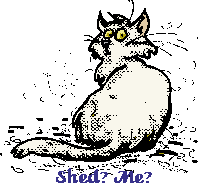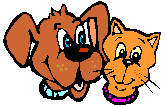
Talking about the health of your Pet's Skin & Coat
One common malady that occurs with temperature changes is problems with a dog
or cat's skin and coat.
Let's define "healthy skin and coat" so we're clear about what is
considered "normal." Don't confuse "normal" with
"common."
Every day in my practice I see pets that have unhealthy skin and coats
(usually due to improper nutrition) - so less than optimum is actually quite
"common." I've often thought a normal skin/coat condition was
actually quite uncommon! Using your senses of touch, vision and smell you will
begin to recognize the character of a "normal" or
"healthy" skin and coat.
Touch
Normal touch: There will be a soft texture to the hairs and even in wiry coats
such as in Airedales the character of the coat should be pliable and smooth.
- Abnormal touch
- The coat will be made up of dry, coarse, brittle hairs, some broken off,
some very fine. The coat may be sparse and thinning or short and
underdeveloped.
Appearance
Normal appearing skin/coat: The skin will have a clean look to it and be free
of scales, scabs and crusts. The coat should appear full, almost lustrous and
have a soft look to it. Abnormal appearing skin/coat: The skin will appear
thin, dry and scaly or greasy. The coat will appear dull, lusterless or even
dusty. It will have no "shine" to it and will have a harsh
appearance.
Smell
Normal skin/coat: A healthy skin and coat won't have any smell to it. And even
when dirty, will smell like whatever is making it dirty.
Abnormal skin/coat: An unhealthy skin and coat will have a rancid, oily odor;
the odor is caused by superficial skin bacteria and their waste products
breaking down the oils on the skin.
All skin surfaces have colonies of bacteria present. But an unhealthy skin
surface harbors too many of the wrong kinds of bacteria. That is why many
veterinarians recommend weekly shampoos with benzoyl peroxide for some dogs
with chronic bacterial dermatitis. These types of shampoos keep bacterial
numbers to a minimum.
The single most important determining factor in the healthy skin/coat equation
is proper NUTRITION.
No matter what else may be adversely affecting the skin/coat, such as
allergies, infections, harsh environment, or parasites, the problem will be
worse in a dog that is only barely meeting its nutrient requirements.
And skin/coat problems are always less severe and occur less often in well
nourished pets. Dogs and cats are primarily meat eaters. They will act, feel
and look their best if fed a diet whose first ingredient listed on the pet
food label is MEAT, POULTRY or FISH.
Diets that are based on grains such as corn will NOT properly nourish dogs
and cats.
The entire field of pet health nutrition is now only beginning to recognize
the value and function of meat-based (poultry, beef, lamb, fish) diets.
Many well known brands of dog and cat foods that have been around for years
and whose foundation (the first listed ingredient on the label) is a grain
such as corn, wheat, barley, or rice simply do NOT provide the health
enhancing nutrients that meat-based diets provide.
Most veterinarians have had only superficial training in pet nutrition and
often that training has been provided by representatives of various dog food
companies.
Shedding
Shedding is not necessarily abnormal. Even if you can grab clumps of fur
and remove them from the pet this hair loss can be normal. Nearly every day in
my practice someone brings in a dog that is losing "tons" of fur and
the owner wants to know what's wrong because it has never done this before.
As long as the skin looks healthy and there remains a reasonably dense coat
where those "clumps" are coming out, and there are no bald spots
showing up, the exuberant shedding is probably normal. Even in northern
climates many outdoor dogs will shed in December or January. Indoor dogs might
shed anytime or even all the time. Hormones, environmental conditions,
nutritional status and probably factors yet to be discovered all play a role
in the cycle of growth, rest, and fall-out of each individual hair shaft.
Tippy & Alfred know that many
skin and coat problems arise from nutritional deficiencies
If your dog or cat suffers from:
Irritated Skin
Excessive Itching
Scratching & Biting
Flaky Skin
Dry or Oily Coat
Excessive shedding
Odorous skin
Dull or brittle coat
Allergies
Then Dr. Jane Bicks recommends her Skin & Coat Formula for Dogs & Cats.
The Skin & Coat Formula has been clinically tested in over 40 veterinary
Clinics and proven effective based on six years and thousands of satisfied
users.
The delicious roast beef and liver flavored chewable tablets have a taste
that dogs and cats love to eat.

Surf on over here to Find
out
More